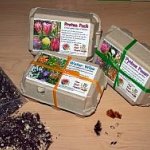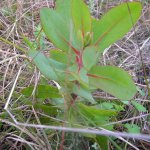Obtaining and growing Protea seeds.
Getting seeds
I first collected my own seeds from proteas in my garden that had died but only about six out of a hundred germinated, so I have decided that collecting my own seed is an option but notoriously unreliable. Protea seeds can be bought from among others, Kirstenbosch Seed Room, Fine Bush People, Silverhill Seeds and Bidorbuy. Remember to order smoke primer when you buy your seeds. If you live in a summer rainfall area, be sure to choose varieties that are suitable to your area (See http://kumbulanursery.co.za/blog/proteaceae-species-for-summer-rainfall-...).
When to plant
Seeds can be sown in autumn or spring when the difference between day and night temperatures is about 12ºC. Where winters are cold, plant in spring and where winters are mild, plant in autumn.
Prepare your soil first
Ideally, the soil should be slightly acidic with a pH of 5.5. A mixture of coarse river sand, peat or decomposed pine needles and vermiculite or perlite in a ratio of 2:2:1 is suggested. As I was unable to acquire coarse river sand or decomposed pine needles, I used finely chipped pine bark, compost and vermiculite. The soil should then be sterilised to kill weed seeds, insect larvae, snail and slug eggs and fungal spores. The simplest method is to drench the soil mix with boiling water. Alternatively, saturate the soil with a fungicidal solution of 40ml of Jeyes fluid to 10 liters of water, but this must be done two weeks before planting the seeds. Seed trays can be used but 500ml black planting bags (one for each seed) are better as there is less chance of disturbing the roots.
Prepare the seeds
To protect seeds from fungal infections and increase the chance of germination, the seeds should be treated with a 'smoke primer' and a fungicidal solution. Prepare the primer by dissolving a disk in 50ml of water at precisely 50ºC and soak the seeds in this for 30 minutes. The seeds are then dipped in a fungicidal solution.
Planting and caring for the seeds
The seeds should be planted to a depth equal to their size and watered well. Use good quality water for the seeds. Salty water, alkaline water or water containing chemicals such as chlorine should be avoided, as well as dam or river water which may contain fungal spores. Rain water is probably the best. Place the seeds in a semi-shaded position and protect them from rodents, birds and insects. A piece of 30% shade cloth is ideal. Water lightly with a fine spray in the early morning and during the day if necessary - do not allow them to dry out at any time. Germination will occur between 1 and 3 months.
When germination occurs, the cotyledons will appear first, followed by the true leaves. Although they can be exposed to full sunlight at this time, it is probably best to keep them protected from insects for some time after germination.
My own experience
Admittedly I did not follow all of the above steps. My soil was not ideally acidic, I did not sterilise it, I forgot to dip the seeds in fungicide and the seed packets dried out a couple of times. As a result I had only a 25% germination rate, but as I had planted 200 seeds, I was satisfied (and probably lucky!) to get 50 plants.
A simpler solution
If the process above seems far too complicated, visit the website for Fine Bush People (http://finebushpeople.co.za). They have a nifty Protea starter pack including soil and seeds which you can grow in an egg box. This is a far easier solution for the home gardener, will provide enough plants for most gardens and can be a fun project for the family.
Acknowledgement
Many thanks to Julie and Charles Oertel of Fine Bush People for permission to use content from their website and the picture of the egg box pack.






Comments
PROTEA REPENS
GOOD MORNING, CAN YOU TELL ME IF THESE SEEDS WILL GROW IN SCOTLAND AS IVE GOT SOME SEEDS AND WOULD LOVE TO TRY AN GROW
YVONNE
Protea repens
Hi Yvonne
I really do not know if these plants will grow in Scotland, but I would go ahead and try anyway. Protea repens is one of the easier proteas to grow and is able to survive in a much wider variety of habitats than other proteas.
I did some research and it appears that if you are situated along the western coast, it may be possible. Apparently, the warm waters of the Gulf Stream affect coastal Ireland, Scotland and Britain, creating milder winters.
If you have icy winters it would probably be best to try the shrub in a large container that could be moved to a sheltered position during winter. I remember my granny covering all her proteas with sacking to protect them from the frost and icy winds we experienced in Johannesburg many years ago, and most of them survived successfully.
If you do decide to try, do let me know as other readers would be interested in your experience.
Kind regards
Lorraine
Protea Repens
I was given a packet of seed by my neighbor, on her return from holidaying in South Africa.
I try growing unusual things, well unusual here in The Netherlands. So she thought I would enjoy the challenge.
This information was very useful, thank you for sharing. Seeds are now planted, 9 of them. So the wait begins.
I already have several lemon trees, not fully grown yet. A date palm, a pistachio and an avocado. All grown from seed.
So here's hoping!
Greetings from
Marion
Add new comment